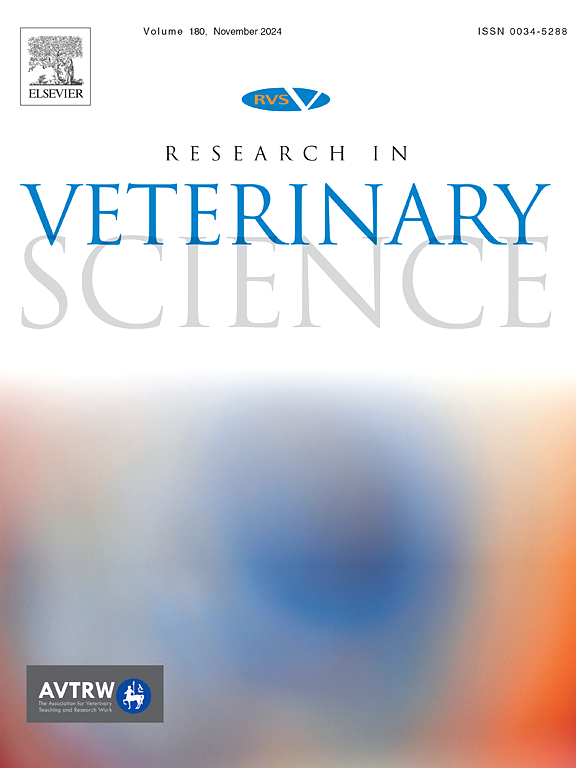家猫(Felis silvestris catus) 6 - 48个月附睾发育的立体学和形态计量学研究
IF 2.2
3区 农林科学
Q1 VETERINARY SCIENCES
引用次数: 0
摘要
本研究研究了家猫(Felis silvestris catus)从青春期到成年期(6至48个月)附睾的年龄相关形态学和形态学变化,强调了附睾在精子成熟和储存过程中的重要作用,这是雄性生育的关键过程。采用组织染色(苏木精-伊红)和sterpanizer软件对42个附睾进行立体定量分析。形态计量学分析显示附睾管直径和头部上皮高度随年龄增长而增加,而尾部上皮高度则逐渐减少,这可能反映了性成熟过程中精子储存能力的适应。形态学观察显示,24至48个月的猫存在上皮内囊肿,并在所有地区和年龄组中一致检测到精子。体视学结果显示,导管上皮的体积密度(%VV)增加,特别是在6至12个月大的头部,支持雄激素活性对区域附睾成熟的影响。这些变化表明附睾实质发生了动态的、与年龄相关的结构重塑,尤其是上皮和管腔成分。虽然这项横断面研究-在南半球春季进行-为附睾发育提供了有价值的见解,但其设计限制了年龄和组织学变化之间因果关系的建立。鼓励未来的纵向研究,检查家猫附睾成熟的激素调节。总的来说,这些发现为猫科动物生殖解剖学提供了基础知识,并强调了附睾作为雄性生殖能力中心的激素反应器官的重要性。本文章由计算机程序翻译,如有差异,请以英文原文为准。
Stereological and morphometric insights into epididymal development in domestic cats (Felis silvestris catus) from 6 to 48 months
This study characterizes age-related morphometric and morphological changes in the epididymis of domestic cats (Felis silvestris catus) from puberty to adulthood (6 to 48 months), emphasizing its essential role in sperm maturation and storage—key processes for male fertility. A total of 42 epididymides were analyzed using histological staining (hematoxylin-eosin) and stereological quantification through the STEPanizer software. Morphometric analyses revealed an age-dependent increase in the diameter of the epididymal duct and epithelial height in the caput, whereas the cauda exhibited a progressive reduction in epithelial height, possibly reflecting adaptations in sperm storage capacity during sexual maturation. Morphological observations showed the presence of intraepithelial cysts in cats aged 24 to 48 months, along with the consistent detection of spermatozoa in all regions and age groups. Stereological findings indicated an increased volumetric density (%VV) of the ductal epithelium, particularly in the caput between 6 and 12 months of age, supporting the influence of androgenic activity on regional epididymal maturation. These changes suggest dynamic, age-related structural remodeling of the epididymal parenchyma, especially in epithelial and luminal components. While this cross-sectional study—conducted during the southern hemisphere spring—provides valuable insights into epididymal development, its design limits the establishment of causal relationships between age and histological changes. Future longitudinal studies examining hormonal modulation of epididymal maturation in domestic cats are encouraged. Overall, these findings contribute foundational knowledge of feline reproductive anatomy and underscore the importance of the epididymis as a hormonally responsive organ central to male fertility.
求助全文
通过发布文献求助,成功后即可免费获取论文全文。
去求助
来源期刊

Research in veterinary science
农林科学-兽医学
CiteScore
4.40
自引率
4.20%
发文量
312
审稿时长
75 days
期刊介绍:
Research in Veterinary Science is an International multi-disciplinary journal publishing original articles, reviews and short communications of a high scientific and ethical standard in all aspects of veterinary and biomedical research.
The primary aim of the journal is to inform veterinary and biomedical scientists of significant advances in veterinary and related research through prompt publication and dissemination. Secondly, the journal aims to provide a general multi-disciplinary forum for discussion and debate of news and issues concerning veterinary science. Thirdly, to promote the dissemination of knowledge to a broader range of professions, globally.
High quality papers on all species of animals are considered, particularly those considered to be of high scientific importance and originality, and with interdisciplinary interest. The journal encourages papers providing results that have clear implications for understanding disease pathogenesis and for the development of control measures or treatments, as well as those dealing with a comparative biomedical approach, which represents a substantial improvement to animal and human health.
Studies without a robust scientific hypothesis or that are preliminary, or of weak originality, as well as negative results, are not appropriate for the journal. Furthermore, observational approaches, case studies or field reports lacking an advancement in general knowledge do not fall within the scope of the journal.
 求助内容:
求助内容: 应助结果提醒方式:
应助结果提醒方式:


